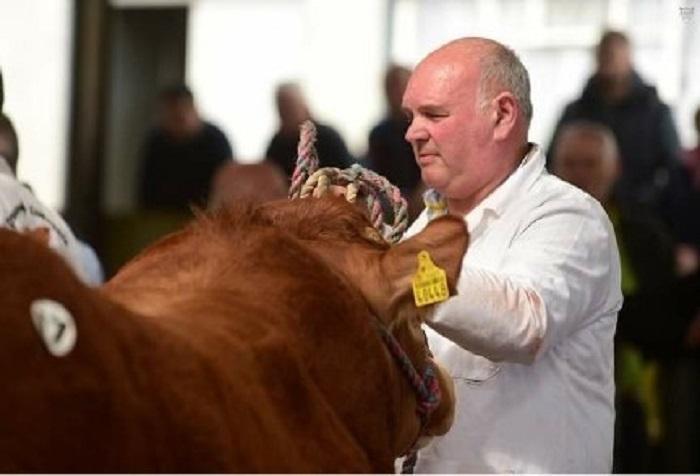08 November 2023
Teagasc in conjunction with Animal Health Ireland recently held a farm walk on the farm of Future beef farmer, Oliver O’Hara. Gabriel Trayers tells us the topics for the walk centred around the best practice for animal health and animal performance over the winter period.
Oliver farms just outside Manorhamilton in Co. Leitrim and typically the housing period can last six to seven months. As a result, the overall welfare of his cattle and the housing environment need to be excelent to ensure that his cattle are thriving and healthy over the winter.
Housing Environment – what is important?
Lying Space
According to Teagasc Grange, overcrowdin pens will have a negative effect on daily live-weight gains over the winter. Therefore, there are specific guidelines for farmers like Oliver to follow.
Recommended housing space allowance (m2 per head)
| Animal Type | Slatted | Straw |
|---|---|---|
| Suckler Cows | 2.5 – 3.0 | 5.0 |
| Calves | 1.5 – 1.8 | 2.4 – 3.0 |
| Cattle 220 – 300 kg | 1.2 – 1.5 | 1.8 – 3.0 |
| Cattle 310 – 450 kg | 1.5 – 2.0 | 2.4 – 3.0 |
| Finishing Cattle 500 – 750 kg | 2.2 – 2.7 | 4.0 |
Research shows that 2m2 is NOT sufficient for finishing animals
Example; One of Oliver’s sheds is a two bay double slatted shed. There are four standard pens each 4.6m x 3.9m, which is 18 sq. metres/pen. In general, Oliver will use two pens for weanlings, which will be 300kg. According to the table above, each animal will need 1.5sq m each. Therefore, each pen could hold a maximum of 12 weanlings. Allowing for increased growth over the winter 10 would be ideal. In terms of cows, 6-7 per pen would be the maximum number. The next step is to ensure that the 10 have adequate feed space. There are guidelines for this requirement also: cows get a lying space of 2.5-3.0 sq metres each.
Feeding Space
Recommended feed space allowances (mm per head)
| Suckler Cows | Finishing Cattle | Light Stores | Weanlings | |
|---|---|---|---|---|
| Feeding Regime | ||||
| Ad-Lib Silage | 400-500 | 400-500 | 250-300 | 225-300 |
| Restricted Silage | 600-700 | 600-650 | 500-600 | 400-500 |
| Concentrates/roots | 600-700 | 600-650 | 500-600 | 400-500 |
The 10 will be offered ad – lib silage so they will need 300m, each that is a total requirement of 3000mm (3m). The pen is 4600mm long so there is plenty of feed space. As Oliver feeds meal ensuring adequate feed space is very important. In order to maximise performance, Oliver will group the pens according to weight and ensures that there is plenty of clean water. He checks the bowls daily to ensure they are not soiled.
Ventilation
Ventilation systems in livestock housing serve an important function in maintaining a comfortable animal environment. Ventilation systems continuously remove the heat, moisture and odours created by the livestock and replenish the oxygen supply by bringing in drier, cooler air from outside. Adequate air exchange also removes gases such as ammonia (NH4), hydrogen sulphide (H2S) and methane (CH4) which can be harmful to both the animal and farmer’s health. Efficient ventilation should also get rid of excess moisture, respiratory disease organisms and dust.
Signs of poor ventilation are:
- excessive condensation on the roof and other surfaces
- mould growth on timbers
- bad odour resulting from odour in the airspace
- wet coats and dirty hides on cattle
A simple smoke test can ascertain the movement of air in the shed. The air should move like the diagram below.
On the evening of the farm walk, a smoke test was conducted in the two bay-slatted shed and it highlighted issues about the lack or air movement i.e. the smoke lingered too long in the shed and it did not follow the pathway shown in the diagram. The reason is that there is not sufficient air getting into the shed through the vented sheeting. A possible solution will be to remove the vented sheeting and replace it with timber space boarding.
Smoke test highlighted a lack of airflow!
Nutrition – Feeding a high quality silage
Oliver took a silage sample and is very happy with the result. Most farmers will look at the DMD first. The target is >72% and Oliver’s silage is 78.76% which is excellent. The next two parameters to look at is the Crude Protein and Dry Matter. The crude protein is 14.64%, which is perfect. The silage is very dry at 43.35% – this high figure could limit intake.
Oliver will feed this silage to his priority stock such as weanlings and any finishing stock. This type of high quality silage will reduce to requirement for meal.
During the winter, the target live-weight gain per day is 0.6kgs for weanlings. With this type of silage, they should not need meal, which is a substantial saving. Feeding a silage below 70%DMD would mean feeding 1.5 to 2 kgs of meal to gain that 0.6kgs/day.
Oliver will not give this silage to cows pre-calving and it is too good! He does not want the cows to get too fat prior to calving. However, it could be fed to cows post calving in February and March.
Animal Health
In summary the advice from the walk was to find out what needs to be treated i.e. take some faecal samples and treat accordingly. A sample will tell you the levels of stomach and lungworms in the cattle. It will also highlight any incidences of fluke.
Oliver clips the backs and tails of all the cattle and will treat all the housed cattle for lice at the same time. It may be necessary to treat for lice again around Christmas.
